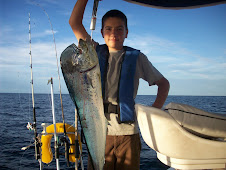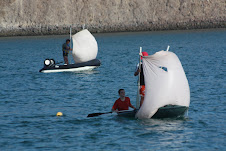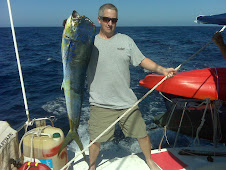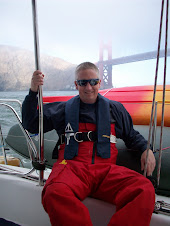***REVISED February 5th and 6th. Toward the end of the posting , I added information I kept gathering through the day of boat damages and the experiences of other cruisers. I also added a little more detail of our position in the group. And I fixed some grammatical and spelling errors for the sake of my mother. I apologize for those - too excited to concentrate on proper English. ***
I've been thinking through the titles for this posting and couldn't pick the one I like best, so I went for all three. Once again, so much has happened in the last week since leaving Stone Island, that I can't even begin to organize it into a cohesive posting. So I'll pick the most exciting story and get through that.
First off, Just a Minute is relatively undamaged and no cruisers suffered injury. I don't know how that is true, but it is.
Unusual weather patterns have been playing havoc with the beautiful weather we should be experiencing in La Cruz. Since we arrived, it has been overcast and the weathermen have stated for days that we were in an "unstable" area of weather. There was going to be lots of rain in the foreseeable future. Well, that's fine. We're from Washington.
So for five days we bobbed at anchor in the swell along with 20 to 30 other boats, coming and going around us. Then two nights ago, all hell broke loose. There were lots of boat anchored that afternoon, enough so that I counted them up - 32 in all. All anchored in a cluster around La Cruz, but no one very close to one another since there was plenty of room. JaM was anchored toward an outside edge of the pack, midway to the shore, at the furthest east edge. There were only a handful of boats further east. It was raining pretty hard when I went to bed around 9:30 and I missed seeing the two gigantic shrimp boats pull in to anchor at the western edge of the pack that night.
The next thing I knew, there was a horrible sound and the boat was jerking and tossing a great deal. I knew it was the wind as I came awake and could see through my hatch that our sun shade was about to be blown off. I jumped up to get dressed and go secure it. Jack was just emerging from his bedroom, as I left mine. Crashes of thunder were booming through the air, frequent lightning flashes gave glimpses of our surroundings. I could tell that the wind was as bad as the 50 knots we had seen at anchor in LA Bay earlier this summer, and I was not too worried since that experience had been such a cake walk for us. I knew our 60# Manson and 150 feet of 3/8th chain was well set in sand at 25' and that we should be fine.
Then the lightning revealed a stupifying sight - boats turned sideways to the wind were flying past us at remarkable speeds. The radio screamed to life with people sending frantic calls. "Mayday, Mayday, This is Stepping Stone. We are on the beach!" The wind had only been blowing about 5 minutes at that point. Patrick was still sleeping through this and we began calling for him to wake up. He is a slow one to wake and was thinking the same thing I had earlier - it's only a wind storm. Patrick was trying to calm Jack down and told him not to worry. We were outside in the cockpit at this time and the wind was throwing rain at us so viciously that we could not look forward very well. Jack said, "Dad, You don't understand. Look!" and he took Patrick's head in his hands and turned it so that Patrick was looking to the side of our boat, just as lightning flashed again. And then Patrick knew. Three boats were flying past just fifty feet off, turned sideways to the wind.
Patrick instantly assumed control and began giving orders as he sat at the helm. "Turn the batteries on! Get life jackets on everyone! Get GPS, Navigation going! Turn all our lights on! Secure the portholes!" Jack and I instantly began working through the orders as they came, all of us working together. Batteries first, so the engines could be fired up and idling. Then life jackets on - that was a hard one. Rudy was hiding under the table and would not get up. I was hitting him, pushing him, trying to drag him out so I could get his life jacket on, and finally had to be happy with two of the three straps secured before giving up and going on to the next task. Rudy was terrified but thankfully did not snap at me as I struggled with him. All of this took about 5 - 10 minutes.
By this time, the waves had worked up to 10 - 12 foot, steep, fast and close. Between the flashes of lightning, the night was pitch black and unfathomable. The wind was so loud that nothing else could be heard, except the calls on the radio. The rain punished our skin, made it nearly impossible to look forward, and drenched us through. Our boat was pitching wildly. Our plant flew off its ledge and crashed into a big mess. Books leapt of the shelves, dishes came out of the cupboards. All things that many boats have experienced before - BUT WE ARE A CATAMARAN. It's unheard of for a catamaran to pitch enough to send a coffee cup sliding over a table, let alone, make it leap out of the cupboard. I kept moving back and forth between cabin and cockpit trying to secure items, and minimize our damage.
Meanwhile, I was terrified that Patrick would be swept from the boat by the wind or accident, so I was getting the harnesses and tethers out. I struggled, trying to put them on Patrick as he manned the helm. At this point, our engines were idling, but since we were not moving on the anchor Patrick was simply sitting there watching the happenings, not really steering or anything. Even, so it was nearly impossible with the pitching to get him into them, and tethered to the boat.
Then things got really interesting. More boats dragging, but these were closer. The first passed within twenty feet. We could see that it was passing close, but safely. But the next flash of lightning stopped our hearts. The lightning revealed a nightmare image of a giant knight on his steed, galloping toward us with his jousting lance aimed at our chest. There was a 50'+ sailboat in the knock down position, hurtling directly at us. The power of the wind had pushed it all the way over on its side, and its mast was skimming over the waves, aimed right at us. It was coming so fast. I was inside with Jack at this moment, Patrick at the helm. He left the helm to come to the cabin door and said, "We are going to be hit. There is nothing I can do. Brace for impact." He then returned to the helm.
A second later, the next flash of lightning revealed that the sailboat was righting itself since the wind had slackened a bit. The mast was no longer a danger to us, but the boat was still bearing down on us, looking to T-bone us between our bows. It was still a nightmare., but a little better. Then Patrick just punched the port engine to the max, our boat lurched and pitched so hard that I thought we had been hit since I was inside and could not see what was happening. The crew of the other boat must have pushed their boat into reverse at the same time because miraculously in the seconds before impact our two boats began to pull away from each other, and passed within inches, the prow of their boat dancing down our life lines and stanchions without really touching. We could have stood on the deck of our boat and easily touched it as it passed. Unbelievably it even missed our fishing net set in a pole holder on the side when a big wave caused their boat's bow to rise wildly and pass just over the top of our net. I came into the cockpit just in time to witness that little miracle. And in the next split second they were past and free to carry on their mad journey. From the time we first saw the knocked-down sailboat until the time it was past took less than a minute.
After that, it became slowly apparent that the wind was slackening slightly. The relief was there, but it wasn't over yet. Boats were still on the move, the waves were still wild. Off to our starboard about 50 feet away, a cluster of four boats were unimaginably close to each other, seemingly locked together in some sort of tangle, still marching past. One's head sail ripped in tatters. The chatter on the radio became incredible. Over-excited people making ridiculous calls, clogging the radio for real traffic. A fight broke out with one woman who refused to stop talking. People were screaming expletives. Then the local weatherman came on and started giving a blow by blow of the weather that had happened.
So when we looked to our bow and saw another boat bearing down on us, Patrick had to call repeatedly "Break, Break" before the man stopped talking. The problem? The boat coming at us appeared to have had a man overboard situation and was empty. It was an eerie sight. The boat's anchor was dragging, but holding enough to keep the bow into the wind, so we had a good view of the stern that was marching slowly towards us. The cockpit was brightly lit by a red light. We could easily see that the gangway door was open, the door in the transom was open, and there was a life ring floating in the water, tied off to the stern. There was no one visible.
After our hail was heard, Patrick described the boat in detail, hoping someone knew something about the crew. The open transom door made the name unreadable. After Patrick described it, a boat that was in the marina came back with the news that it sounded like the boat "Amistad" and that if it was, the owners were safely on land. Great! That eased our great concern about a man overboard, but we still had another boat to dodge. And this time, we had to do it without the other boat's help. Thankfully, the wind was dying off quickly and was now down to the 20 knot range, but the waves were still wild and the boat was hopping backwards on the waves, aimed directly to hit us between our bows. It was a beautiful boat, twin helms, new and fast looking. It was going to make us into one nice looking trimaran. By this time it was about 40 feet off, directly in front of us.
It became apparent that the only way to avoid it was to pull up anchor. I manned the helm and Patrick and Jack crawled forward to work as a team to pull the anchor. As it continued to march closer, I eased into forward and Patrick began pulling in the chain on the windlass. We knew we simply couldn't steer out of its way like we had the last time because it would snag our anchor chain with its dragging anchor, and then we would be in a world of hurt. But obviously, pulling in the anchor brought us closer and closer to the stern of the dragging boat. I kept bumping the port engine to move us over but I couldn't go too far without messing up the anchor. We passed within 7 to 10 feet of it, but it went well. And then we were free!
Now we were feeling great relief. The wind continued to die as we motored through the boats that were left, heading toward the marina entrance. Within 15 more minutes we were tied to the dock and breaking out the grog and Coca-cola for the crew. Drenched, shaking, absolutely wired. We were the first boat in but soon, many more were joining us from the anchorage.
The intense winds lasted about 45 minutes to an hour. It started at 10:30 pm, and we were docked around 12:30. The storm caught everyone by surprise. Multiple people clocked 80 to 88 knots on their anenometers. Some say they saw up to 100. Two separate people on land reported seeing a funnel cloud converge on the boats at anchor. The wind just before the squall struck was a comfortable 5 knots from the SE, which put JaM at the head of the pack. Then from the NW 80 knots slammed into the sterns of the boats in one instant - like a giant fan being turned on. Suddenly JaM was at the back of the pack like a bowling pin in an alley. Except in this bowling game, there was one pin and about 25 or more bowling balls.
Within the first five minutes, several wind generators exploded, canvases shredded, and multiple anchor snubbers broke. Throughout the night, multiple dinghies were lost or flipped, and at least four boats completely parted from their anchors and were free falling through the anchorage, wildly out of control. The vast majority of boats dragged, some up to a 1/3 mile. Several boats report taking on water when they were knocked down. One owner told me he was 5 minutes from his boat from sinking when it was knocked down and green water began rushing in through three open portholes.
At least two boats report their anchors were twisted and bent from the force put on them. I know of eight boats which were involved in collisions with other boats, most receiving fairly significant damage - stanchions and life lines mangled or ripped out, metal toe rails gouged, twisted and bent, some fiberglass holes high on the boat, bow pulpits crushed, anchor rollers knocked off, and more. There may have been others involved in collisions, but I haven't heard, as most of the boats once at anchor are now tucked throughout this huge marina trying to assess the damage and seek repairs.
We met a man on the beach who owns a beach house positioned close to the anchorage. He states that every window that was facing the bay was blown out - EVERY window. He also said he was in his house during the hurricane that struck Banderas Bay in 2002 and "this was much worse" based on the extent of his damage.
No one was injured, and no cruiser boats lost - not even "Stepping Stone". This family of four called the Mayday at the beginning of the night. Their anchor was lost quickly when the rode separated from the chain. Their boat was pushed up on land, tilting to the side. Elias turned off the engines. Then unbelievably, they found themselves pushed free again and floating. So he cranked the engines back on and floored it - safely motoring back off the beach and out into deeper water.
The docks are like a giant encounter session as survivors tell their stories and show their damage. And boy, did we learn some good lessons on JaM. We did so well together. Everyone worked together, stayed calm enough to do their jobs and kept it together. Jack was an invaluable help. I am so grateful for coming out of this basically unscathed. Our only damage was our lazy jacks that hold in the mainsail blew apart (almost releasing the main, but not quite). And some seams on our bimini cover were ripped apart.
And the problem with big anchors? They hold you in place while seemingly everyone else flies at you.
What an experience to add to our life list! An adventure worthy of great adventurers, let alone little old us.
Laura
















